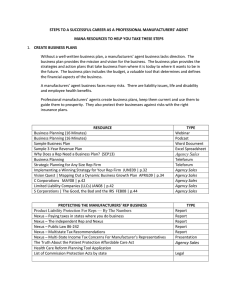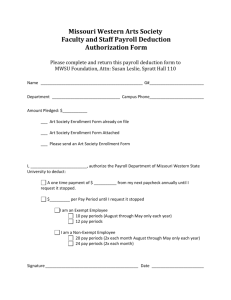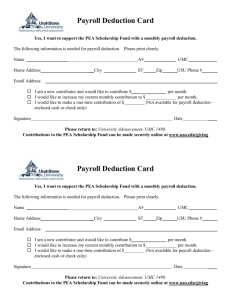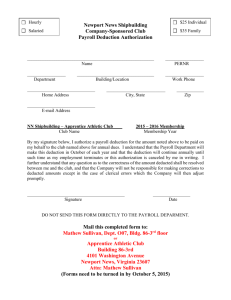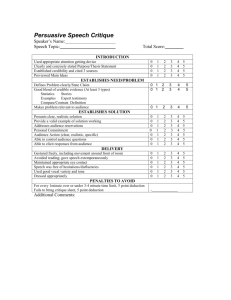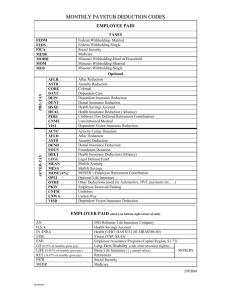Page 4 - Mueller Prost
advertisement
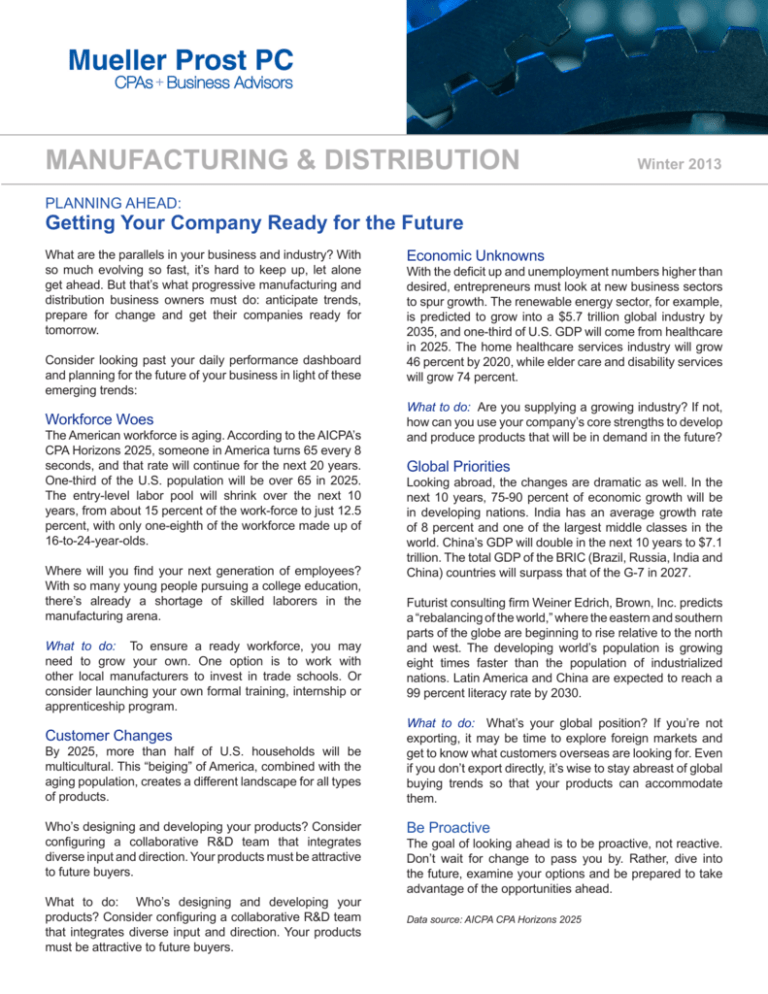
MANUFACTURING & DISTRIBUTION Winter 2013 PLANNING AHEAD: Getting Your Company Ready for the Future What are the parallels in your business and industry? With so much evolving so fast, it’s hard to keep up, let alone get ahead. But that’s what progressive manufacturing and distribution business owners must do: anticipate trends, prepare for change and get their companies ready for tomorrow. Consider looking past your daily performance dashboard and planning for the future of your business in light of these emerging trends: Workforce Woes The American workforce is aging. According to the AICPA’s CPA Horizons 2025, someone in America turns 65 every 8 seconds, and that rate will continue for the next 20 years. One-third of the U.S. population will be over 65 in 2025. The entry-level labor pool will shrink over the next 10 years, from about 15 percent of the work-force to just 12.5 percent, with only one-eighth of the workforce made up of 16-to-24-year-olds. Where will you find your next generation of employees? With so many young people pursuing a college education, there’s already a shortage of skilled laborers in the manufacturing arena. What to do: To ensure a ready workforce, you may need to grow your own. One option is to work with other local manufacturers to invest in trade schools. Or consider launching your own formal training, internship or apprenticeship program. Customer Changes By 2025, more than half of U.S. households will be multicultural. This “beiging” of America, combined with the aging population, creates a different landscape for all types of products. Who’s designing and developing your products? Consider configuring a collaborative R&D team that integrates diverse input and direction. Your products must be attractive to future buyers. What to do: Who’s designing and developing your products? Consider configuring a collaborative R&D team that integrates diverse input and direction. Your products must be attractive to future buyers. Economic Unknowns With the deficit up and unemployment numbers higher than desired, entrepreneurs must look at new business sectors to spur growth. The renewable energy sector, for example, is predicted to grow into a $5.7 trillion global industry by 2035, and one-third of U.S. GDP will come from healthcare in 2025. The home healthcare services industry will grow 46 percent by 2020, while elder care and disability services will grow 74 percent. What to do: Are you supplying a growing industry? If not, how can you use your company’s core strengths to develop and produce products that will be in demand in the future? Global Priorities Looking abroad, the changes are dramatic as well. In the next 10 years, 75-90 percent of economic growth will be in developing nations. India has an average growth rate of 8 percent and one of the largest middle classes in the world. China’s GDP will double in the next 10 years to $7.1 trillion. The total GDP of the BRIC (Brazil, Russia, India and China) countries will surpass that of the G-7 in 2027. Futurist consulting firm Weiner Edrich, Brown, Inc. predicts a “rebalancing of the world,” where the eastern and southern parts of the globe are beginning to rise relative to the north and west. The developing world’s population is growing eight times faster than the population of industrialized nations. Latin America and China are expected to reach a 99 percent literacy rate by 2030. What to do: What’s your global position? If you’re not exporting, it may be time to explore foreign markets and get to know what customers overseas are looking for. Even if you don’t export directly, it’s wise to stay abreast of global buying trends so that your products can accommodate them. Be Proactive The goal of looking ahead is to be proactive, not reactive. Don’t wait for change to pass you by. Rather, dive into the future, examine your options and be prepared to take advantage of the opportunities ahead. Data source: AICPA CPA Horizons 2025 MANUFACTURING & DISTRIBUTION | Winter 2013 p2 WORD TO THE WISE Avoid Surprises with Cash Flow Forecasting If cash is king, this makes cash flow forecasting a noble pursuit. • How much do you need to reinvest in equipment each month, and how will this be financed? A cash flow forecast estimates how much cash will flow in and out of a company over a period of time. Owners of manufacturing and distribution companies use cash flow forecasting to identify potential cash crunches, plan for financing and analyze how the business is performing relative to its strategic plan. • How much money do you need to pay down short-term and long-term debt? Knowing what to expect in terms of cash flow is especially helpful for seasonal businesses because it lets executives plan more accurately and spend more efficiently throughout the year. This type of forecasting is also important for businesses with a concentration of customers. Having fewer customers means potentially greater variability in cash flow, especially if one or two big customers is having trouble paying. Getting Started Many manufacturers and distributors roll cash flow forecasting into their budgeting every year. It’s a very straightforward process involving a few key drivers: • How much net income do you think you’ll have every month? • How quickly are your customers paying? Most manufacturers and distributors have receivables days outstanding in the range of 35-55 days, so invoices in September become cash in October and November. • • How quickly do you have to pay your bills, including payroll? Some manufacturers and distributors are employee intensive, which means they have regular and substantial cash payroll commitments every two weeks or so. Other companies are vendor intensive and can pay a bit faster or slower depending on cash flow. How quickly does your inventory turn over? This ratio should align with purchasing and sales forecasts. Once these numbers are calculated and entered into a 12-month spreadsheet model, you can easily see how your company’s cash moves in and out of the bank — and where any deficits might be lurking. Review the forecast at the beginning of each month, noting the receivables and payables due in the next 30 days. Does the difference between your company’s income and expenses equal the amount you originally estimated? If not, you’ll need to take quick action — ramping up collections efforts, for example — to make the numbers work. What If? One of the most important parts of cash flow forecasting is manipulating the numbers to analyze various “what if?” scenarios. For example, suppose yours is a seasonal business and the weather poorly affects your income during what should be your busiest months. What will that dip in revenues do to your cash flow? Or, say one of your major customers slows payment by 10 days every month. How will that slower income stream impact your ability to pay your existing debt or buy new equipment? Most owners find that modeling these “what if?” scenarios is a helpful stress reducer. It allows them to anticipate both good and bad circumstances and use their resources wisely. Most important, it helps them avoid surprises, see abnormalities and make quicker corrections. Remember: Without a cash flow forecast, you’re overlooking a critical part of your business planning process. So it’s wise to get started right away. Our firm can help you with your cash flow forecast. Contact John Oeltjen, CPA today to schedule a time to talk about next steps. Via telephone at 314.862.2070 or by email at joeltjen@muellerprost.com. MANUFACTURING & DISTRIBUTION | Winter 2013 p3 TAX TOPICS Be Aware of State and Local Tax Liabilities With so many important things to think about, many business owners don’t consider state and local taxes (or SALT) to be much of a concern. But, if you’re doing business — any business — in another state, you may be subject to SALT, which can significantly impact your cash flow and effective tax rate. It all comes down to a concept referred to as nexus. This refers to any connection between your company and a given state that would indicate that you have a presence in that state and might therefore owe income or sales taxes there. Note that nexus does not necessarily require a physical presence, such as an office or warehouse in the state. For example, your company may have nexus simply by having employees living in the state. near a state border, where employees may live in one state and work in another. In this case, withholding can be complicated because it involves both states’ laws, although some adjoining states have reciprocation agreements. If you are a distributor traveling through several states, you may be subject to payroll tax in various states, depending on how aggressive the states are about what constitutes employees’ physical presence. • Nexus does not necessarily require a physical presence Defining Nexus Nexus is defined differently for different types of taxes. Having nexus for sales tax purposes doesn’t necessarily mean your company will have nexus for income tax purposes. Here is what you should know: Income tax – Generally, if your company derives income from sources within a state, has a physical presence in a state or has employees who live in a state, it is subject to income tax there. Of course, defining “sources within a state” is not always easy. Public Law 86-272 specifically restricts a state from collecting income tax on income derived from employing a salesperson in a state, as long as his or her orders are fulfilled in another state. This is a very limited exception and severely restricts what the salesperson can and cannot do in the state, and covers only sales of tangible personal property. • Payroll tax – Generally, companies must collect and remit payroll taxes in every state where employees are located. This is relatively straightforward unless your company is located Sales tax – If you ship goods to other states, you will likely be required to collect and remit sales tax in those states. In theory, consumers are already supposed to pay sales tax on online purchases. But in reality, not many online retailers collect sales tax everywhere they should. As Internet sales continue to grow, it’s likely that all states will eventually require outof-state sellers to collect and remit sales tax. A bill called the Marketplace Fairness Act would allow states to choose to collect tax from online businesses with more than $500,000 in sales in their states. Interestingly, Amazon is backing the bill, but eBay, Overstock and other online retailers are opposing it. • Franchise tax – About half of the states impose a franchise tax for the privilege of doing business in the state. This tax is calculated on a basis other than income, such as the company’s net worth or gross receipts. This type of tax is imposed under various names — business tax, margin tax or commercial activities tax. Don’t Neglect SALT Given their current economic challenges, most states are hungry for revenue, so they are getting more aggressive about collecting SALT. If there’s a chance your company might be subject to these taxes, don’t look the other way. Neglecting a tax liability can result in significant penalties and interest. MANUFACTURING & DISTRIBUTION | Winter 2013 p4 Take Advantage of Commercial Building Tax Deduction Thanks to the Energy Policy Act of 2005, commercial building owners can benefit from the Section 179D tax deduction for installing energy efficient HVAC and hot water systems, upgrading interior lights or making improvements to the building envelope. The incentive applies to both new construction and renovations. To claim the incentive, certification must be performed by an independent, professional engineer or other qualified individual. Materials and systems must be placed in service before December 31, 2013, but there’s currently a proposal in the Senate to extend the deduction beyond this year. The Basics For manufacturers and distributors, the Section 179D deduction may be relevant beyond their own facilities. While capital improvements to buildings are generally depreciated over a lengthy 39 years, this incentive allows an immediate deduction of up to $1.80 per square foot. To qualify for the full $1.80, energy and power costs must be reduced by at least 50 percent when compared to a hypothetical reference building built to an outdated standard that’s not difficult to meet. For reductions of less than 50 percent, buildings may still qualify for partial deductions of $.60 to $1.20 per square foot, depending on the energy savings. The IRS issued Notice 2012-26 last spring that made it easier for certain projects to qualify for the partial deduction by lowering the required energy savings percentages. Going Beyond Manufacturers and distributors of energy-reducing HVAC and hot water systems, lights or materials that increase the energy efficiency of a building envelope can use this program to drive sales. In effect, the deduction acts as a federally subsidized incentive to purchase your products. Contact John Oeltjen, CPA to find out how you might benefit from the Section 179D deduction. Via telephone at 314.862.2070 or by email at joeltjen@ muellerprost.com. Mueller Prost PC offers practical solutions and insightful advice to individuals, businesses and non-profit organizations, providing a full range of audit, tax, accounting and business advisory services. The experience of our more than 80 accountants, engineers, operations leaders and former business owners gives us a unique and comprehensive perspective to address the needs of growing organizations. In addition, we leverage our membership in PKF North America (an association of more than 100 legally independent accounting and consulting firms) to enhance our national and international capabilities. For more information, visit www.muellerprost.com. The firm offers a full range of professional tax, audit, accounting and management advisory services to the manufacturing and distribution industry. For more information, please contact John E. Oeltjen, CPA at 314.862.2070 or joeltjen@muellerprost.com. Advising with Vision® www.muellerprost.com
